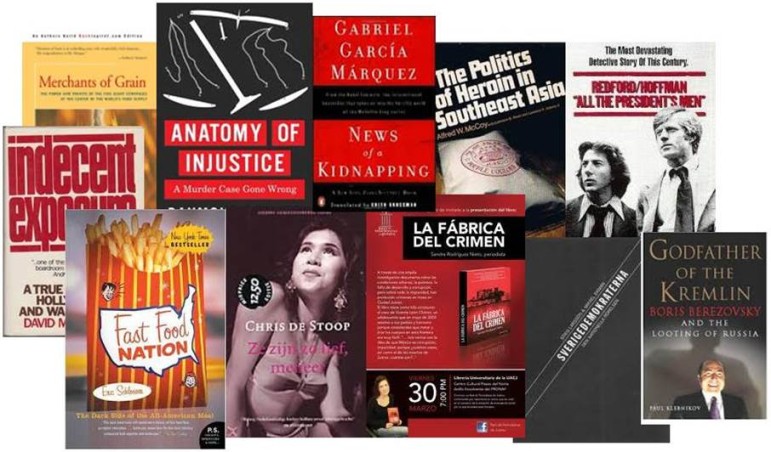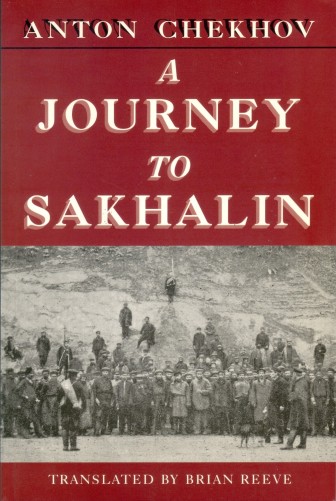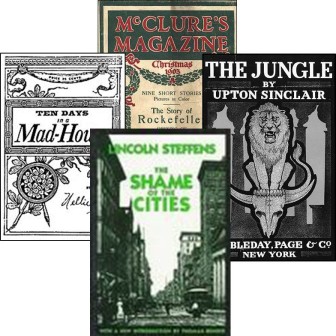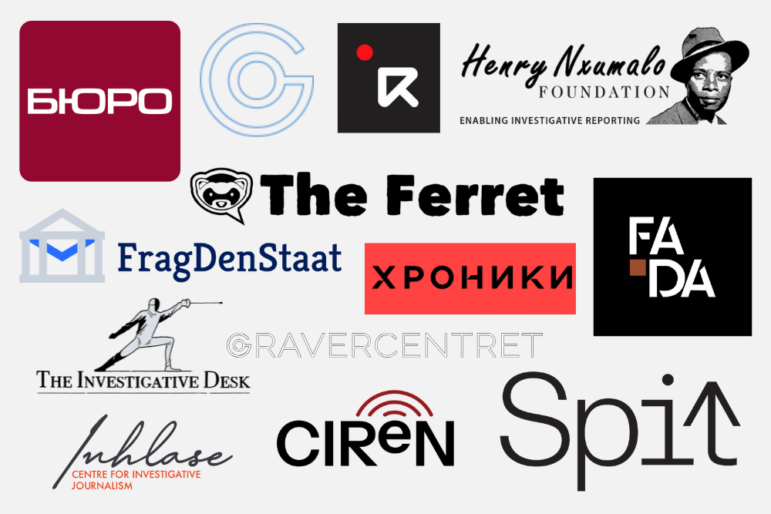Toward an IJ Canon: Recommended Readings and Films from the Global Investigative Journalism Network and Story-Based Inquiry

In June 2013, we invited our colleagues in the Global Investigative Journalism Network to name the book-length works of journalism, scholarship, and even fiction that had influenced their practice as investigators. The resultant list isn’t comprehensive – though we invite you to help complete it by sending us your favorites, including full title, authors, publication or broadcast date, a one-line bio to identify yourself so we can give you credit, and two or three lines that explain why you find a given work special. (Let someone else recommend your own stuff, please. We made a couple of exceptions here, but we checked them out first. We can’t do that indefinitely.) This is the rule: If you don’t think it’s terrific in at least one important way, don’t tell us about it.
Incidentally, we edited the list to take out manuals and articles; the former should be submitted to GIJN’s resource page on Investigative Journalism Manuals, and the latter should be compiled as a separate list. (Someone else will have to do that. I already put together a free anthology of articles, The Global Investigative Journalism Casebook (UNESCO 2012) and that’s enough for now.)
The list as it stands is surprisingly coherent; some of the same names keep appearing. There’s consensus on what makes work great – high level research, analysis and composition. If you’re teaching IJ, you will find material here you can use in your classes, whether you teach in English, Dutch, French, Italian, or Spanish. (We’ll also take suggestions in other languages, but please write the notice in English.) Looking at the list, I felt very glad I had seen some of this work, and that I had more to see. We hope your students and colleagues will feel that way, too.
This project is and will remain open source, meaning that you can make free use of it and modify it as long as you inform other users of your mods. Please give this credit if you hand it out or publish: “Compiled by Mark Lee Hunter with members of the Global Investigative Journalism Network.” We will eventually incorporate it as a free add-on to a curriculum for teaching investigative reporting that we are developing in cooperation with Arab Reporters for Investigative Journalism.
Stephen Doig, Knight Chair of Journalism, Arizona State University (US), recommends:
Precision Journalism by Phil Meyer (1972): a call for reporters to use social science methods, which touched off the data journalism revolution. Still a valuable and useful read.
Lyra McKee, founder of The Muckraker (UK), recommends:
Check out Jeremy Scahill’s Dirty Wars and Woody Klein’s The Inside Stories of Modern Political Scandals: How Investigative Reporters Have Changed the Course of American History.
Stephen Grey, Reuters journalist and author (UK), recommends:
Merchants of Grain: The Power and Profits of the Five Giant Companies at the Center of the World’s Food Supply, by Dan Morgan (1976). Still not to be missed by anyone.
The Box: How the Shipping Container Made the World Smaller and the World Economy Bigger by Marc Levinson (2006). An essential investigation into the world trading system; impossible to understand globalisation without this book.
On Criminal Justice:
Anatomy of Injustice: A Murder Case Gone Wrong, by Ray Bonner (2012),an unmissable look at the US death penalty system by one of the greats.
On War:
– Neil Sheehan, A Bright Shining Lie (1988) offers a classic example of telling the big story of a war by focussing on the tale of one man’s contribution, Col John Vann.
– Dispatches by Michael Herr (1977) is the story that inspired “Apocalypse Now”. War writing at its best – and deadly insight.
– The Politics of Heroin in Southeast Asia by Alfred W. McCoy is a subversive look at the CIA’s role in Vietnam. (This is deep dark, digging — still don’t know if it is all true!).
Politics:
– All The President’s Men (the book and film)- so yes, we hate to admit it, and we have our gripes – but who wasn’t inspired by this?; and of course by The Insider (1999), the film with Russell Crowe on CBS vs Big Tobacco.
Sleuthing:
– Chinatown (1974) – no better film, no better look at probing into dark corners where you’re not wanted…. and where those who are supposed to be looking out for us are looking the other way.
Mrs. Mulwray: What were you doing there?
Gittes: Working for the District Attorney.
Mrs. Mulwray: Doing what?
Gittes: As little as possible.
Mrs. Mulwray: The District Attorney gives his men advice like that?
Gittes: They do in Chinatown.
Follow Global Investigative Journalism Network’s board Investigative Books & Films on Pinterest.
Drew Sullivan, co-founder of the Organized Crime and Corruption Reporting Project (Bosnia), recommends:
These may not be the greatest books but they inspired me:
Endless Enemies by Jonathan Kwitny (1986). Here the late, great IRE member looked at how US foreign policy was often self-defeating. The book covers various US led coups, the Dulles brothers, The Times reporter in Iran working for the CIA and other gems. Also, his book on the Nugan Hand Bank, The Crimes of Patriots (1987) was a classic.
Godfather of the Kremlin, by Paul Klebnikov, is the book that probably got Klebnikov killed. A withering look at gangster capitalism in Russia during the Yeltsin years. It especially tells the tale of the weasel-like Boris Berezovsky who recently died to much rejoicing.
(Andrew Weir comments: I also wish to endorse the Klebnikoff book. It has never been rivalled for opening up the Russian kleptocracy.)
In Red Mafiya (2000) the late, great Robert Friedman singlehandedly reported on the Russian mafia in the 90s, especially looking at money laundering through the Bank of New York.
Illicit by Moises Naim (2006). The book is subtitled “How Smugglers, Traffickers and Copycats are Hijacking the Global Economy”, and that tells you everything. Misha Glenny’s far inferior effort McMafia seems to have borrowed every theme from this book.
And I second McCoy’s The Politics of Opium. It’s a dated classic but explains in detail how the US Government moved drugs through Laos and Cambodia during the Vietnam war. It started out more as an anthropological study but the fact that the author spent a lot of time in the region during the 1960s gives it a unique credibility.
(Mark Lee Hunter comments: McCoy spoke about the book at the CIJ summer school a few years ago. Very impressive talk. He went to a general’s house and said, “People say you are stealing from others in the heroin trade.” The general showed McCoy his account books to prove he was honest.)
All of Paul Williams’ books, usually set in Ireland, are fun and easy reads.
On the fiction side, “The Wire”, the HBO series, has some real honest-to-goodness investigative reporting in it, but it’s usually done by the cops and not the journalists. Like when Lester tracks down how the street gangs are laundering money through community development projects and using proxies to hide ownership. Good stuff.
In The Puzzle Palace by James Bamford, he takes on probably the most difficult subjects an investigative reporting can tackle – the top secret National Security Agency. Yet he collects an amazing amount of information. It’s a pretty impressive book and he had to fight like hell to get it published. He followed it up with two more on the NSA, A Pretext for War and The Shadow Factory, which demonstrate the same reporting prowess.
Mark Lee Hunter, author, editor, and reporter (France), recommends:
Vicious Circles: The Mafia in the Marketplace, by Jonathan Kwitny (1979). A masterpiece of insight into organised crime, written in a natural, compelling style.
David McClintick’s Indecent Exposure (1982) is not only a great narrative, it’s the great (nonfiction) business novel that all the literary critics were weeping and whining for, but couldn’t take from a reporter.
Erin Brockovich (2000), a film by Steven Soderbergh starring Julia Roberts, does a brilliant job of showing how to build source relationships with dreadfully victimized people – and thus to attract other sources who know how they were victimized. There is more tradecraft in this film than in All the President’s Men.
Le pull-Over Rouge by Gilles Perrault (1978). In a narrative that manages to be breathless and crushing at once, Perrault shows that the last man guillotined in France was caught between a one-sided official “investigation” and an incompetent defender. Thanks to this book, the death penalty became history in France in 1981.
Au Bagne by Albert Londres (1928). There’s a reason this inquiry into France’s prison colony at Cayenne became a classic — it’s real-world Kafka. Londres attacks a system, and proposes four reforms to end it. He did.
L’Affaire du Sang by Anne-Marie Casteret (1992). The single greatest book, and investigation, in the history of French journalism. Casteret proved that high officials of the French State knowingly sold blood products contaminated with the AIDS virus to hemophiliacs. Her revelations shattered the responsible government, and follow-up reports still make the news. Masterful medicine-meets-crime reporting.
Margo Smit, director of the Dutch-Flemish investigative journalists’ association, VVOJ (Netherlands), recommends works in Dutch and German:
Chris de Stoop’s book on the traffic in women: Ze zijn zo lief, meneer (‘they are so sweet, sir…’), from 1992. (Mark Lee Hunter comments: A masterpiece that combines undercover and documentary research into a stunning narrative of oppression and injustice.)
Here in the Netherlands a book that inspires my students at the moment is the story of how ABN Amro (a Dutch bank) was nationalized back in 2008: De Prooi (The Prey, 2009), written by Jeroen Smit, current professor of journalism at Rijksuniversiteit Groningen. I consider it a must read.
Much more influential (in books and magazines) is the work of the German investigative reporter Gunther Walraff.
Gerard Ryle’s book Firepower: The most spectacular fraud in Australian history (2009) was the predecessor to Offshore Leaks and a major work Down Under.
Eric Hennekam, VVOJ member and specialist in archival research (Netherlands), recommends:
Legacy of Ashes: The History of the CIA, by Tim Weiner (2007).
All the journalism work of Karl-Stig-Erland “Stieg” Larsson, like Sverigedemokraterna: den nationella rörelsen (2001).
Andrew Weir, investigative author and reporter (UK), recommends:
Knowing the Vietnam literature as I do, let me add one indispensable volume to (Stephen Grey’s) very fine choice of three great books on that war: The Quiet American, by Graham Greene (1955). Fiction perhaps, but one of those cases where fiction speaks truer than reportage.
Also Hunter Thompson’s long-neglected piece of investigative reportage, Hell’s Angels: The Strange and Terrible Saga of the Outlaw Motorcycle Gangs (1966).
Lise Olsen, investigative reporter at the Houston Chronicle (US), recommends in English and Spanish:
Mort Rosenblum’s book, Little Bunch of Madmen (2010) is full of bits of wisdom from great reporters around the world.
Mexican reporter Sandra Rodriguez’ 2012 book – an investigative biography of a teenager in Juarez who arranged the kidnapping/murder of his own sister and parents, and then tried to blame it on organized crime and collect ransom – is chock full of facts but written in an outstanding narrative style: La Fábrica del Crimen.
I have used the excellent documentary “La Doble Desaparecida” (CNN in Spanish, 2003) to talk about investigative reporting – excellent example of the use of documents and confrontational interviews and just an amazing tale. Available at http://vimeo.com/38926180.
Con la muerte en el bolsillo (2005) by Mexican investigative reporter and public records expert Maria Idalia Gomez – a long-time investigator of attacks against journalists for the IAPA – and her partner Dario Fritz is a great investigative book about drug trafficking.
My absolute favorite investigative book in English is The Looming Tower: Al Qaeda and the Road to 9/11 (2006). A tour de force of writing and reporting by Lawrence Wright. Reading any of the amazing chapters and looking at the footnotes would be instructive for any level of journalism study.
Serena Tinari, investigative reporter and filmmaker, recommends works in English, Italian and French (Switzerland):
If you’re investigating Big Pharma, read these:
Marcia Angell: The Truth about the Drug Companies (2005)
Jacky Law: Big Pharma: Exposing the Global Healthcare Agenda (2006)
John Le Carré: The Constant Gardener (2001)
Merrill Goozner: The $800 Million Pill: The Truth behind the Cost of a New Drug (2004)
Ray Moynihan and Alan Cassels: Selling Sickness: How the World’s Biggest Pharmaceutical Companies Are Turning Us All into Patients (2005)
Catherine Riva and Jean-Pierre Spinosa : Pourquoi vaccine-t-on les jeunes filles contre le cancer du col de l’utérus? La piqûre de trop (2010)
Marco Bobbio: Giuro di esercitare la medicina in libertà e indipendenza (2004)
Ray Moynihan and David Henry: Disease Mongering (2006)
Florence Graves, founding director of the Schuster Institute for Investigative Reporting (US), recommends:
Brooke Kroeger’s Undercover Reporting: The Truth About Deception (2012), which makes the case for the importance of undercover reporting. See also the astonishing companion database of hundreds of undercover stories that she created and made available at New York University: http://dlib.nyu.edu/undercover/
Abdullah Vawda, executive director of the Forum for African Investigative Reporters (South Africa), recommends:
We suggest Killing for Profit: Exposing the Illegal Rhino Horn Trade by Julian Rademeyer (2012), described correctly by Amazon as “a meticulous, devastating and revelatory account” of wildlife trafficking.
Paul Lashmar, investigative journalist and professor at Brunel University (UK), recommends:
I would look at Andrew Jennings’ excellent work on the global football association, FIFA, notably Foul: The Secret World of FIFA (2006).
Two of Robert Whitaker’s books are among the most cited in the critical psychiatry literature: Mad in America (2002), and Anatomy of an Epidemic (2010). Whitaker’s work has alerted both the medical community and the general public to the serious dangers of psychotropic medicines when used for extended periods. He has become a standard reference for the facts.
Ana Arana, director of Fundación MEPI (Mexico), recommends:
From Latin America I would include The Art of Political Murder, by Francisco Goldman (2008), on the murder of Bishop Juan Gerardi, Guatemala’s leading human rights activist, who was bludgeoned to death in 1998, two days after the presentation of a groundbreaking church-sponsored report implicating the military in the murders and disappearances of some two hundred thousand civilians.
Gabriel Garcia Marquez’s News of a Kidnapping (1998) details the kidnapping, imprisonment, and eventual release of a handful of prominent journalists and others in Colombia in the early 1990s by the Medellin drug cartel, operated by the late Pablo Escobar. (Mark Lee Hunter notes: Marquez was a famous journalist before he became a famous novelist. He remains a great reporter – an implicit answer to the dumbbell notion that journalism necessarily corrupts artists.)
Anne Marie O’Connor’s The Lady in Gold (2012) tells of the portrait of Adele Bloch-Bauer, a Jewish Heiress and Gustav Klimt’s muse and patron in turn-of-the-century Vienna, its fate under Nazi rule, and the battle to recover it by survivors in the US and Canada.
Jared Diamond’s Pulitzer Prize winning book Guns, Germs and Steel (1997) looks at how environmental factors had a decisive influence on human history. (Mark Lee Hunter comments: You can debate over whether or not this is investigative, because it reveals no secrets. What it does do is use open sources – specifically, the scientific literature from a stunning range of fields – to weave a convincing theory of how human society evolved differently in Europe and elsewhere.)
Finally, The Children of Sanchez by anthropologist Oscar Lewis (1961). A classic example of scientific field work and close observation.
Luuk Sengers, author and reporter (Netherlands), recommends:
Mark Schapiro’s book Exposed: The Toxic Chemistry of Everyday Products and What’s at Stake for American Power (2009) is an example of his craftsmanship. I think he’s the single best environmental investigative reporter around. He set the standard for a generation after him (in which I count myself), showing that environmental reporting is not for treehuggers or the fainthearted.
Another book that should not be absent from our list is Fast Food Nation: The Dark Side of the All-American Meal by Eric Schlosser (2001). Schlosser took on McDonalds, Coca Cola and their sorts… without getting sued! Proof that documentation does not have to get in the way of storytelling.
I remember the impact of yet another great book on raving young economy reporters in the 90s: Barbarians at the Gate: The Fall of RJR Nabisco, by Bryan Burrough and John Helyar (1990). It completely revolutionized the way we wrote about companies: less focus on money and structures, and more on power and people.
David Kaplan, GIJN executive director (US), recommends:
A selection of winners from the book category of the IRE Awards over the past 15 years. These are works chosen by fellow investigative journalists in large part for their impressive methodology and intensive research. I’ve listed below books which may have a more international appeal. You can see the full list going back to 1979 on IRE’s website.
- 2011: Render Unto Rome: The Secret Life of Money in the Catholic Church, by Jason Berry
- 2010: Anatomy of An Epidemic: Magic Bullets, Psychiatric Drugs, and the Astonishing Rise of Mental Illness in America, by Robert Whitaker
- 2008: The Shadow Factory: The Ultra-Secret NSA from 9/11 to the Eavesdropping on America, by James Bamford
- 2007: Curveball: Spies, Lies and the Con Man Who Caused a War, by Bob Drogin
- 2006: The Looming Tower: Al-Qaeda and the Road to 9/11, by Lawrence Wright
- 1998: A Promise of Justice: The Eighteen-Year Fight to Save Four Innocent Men, by David Protess and Rob Warden.
Going back to the 1960s, these books played key roles in establishing modern environmental, consumer, and organized crime reporting:
- Silent Spring by Rachel Carson (1962). The book launched the environmental movement and, with it, today’s environmental journalism.
- The American Way of Death by Jessica Mitford (1963). This exposé of the funeral industry, by British muckraker Mitford, is a classic.
- Unsafe at Any Speed by Ralph Nader (1965). This book, on the dangers of automobile design and the industry’s cover-up, helped launch modern consumer reporting.
- The Grim Reapers by Ed Reid (1969). A fearless city-by-city report on the American Mafia’s extraordinary influence in the 1960s, by a Pulitzer Prize-winning newspaperman.
To this I would add the best-known works of the Muckrakers, the Progressive-era journalists who laid the foundation for modern investigative reporting in the United States:
- The History of the Standard Oil Company, by Ida Tarbell (1904). Tarbell’s exposé of abuses by Standard Oil, among the most powerful corporations of its time, is a model of careful, systematic research and reporting. It began as a series in McClure’s Magazine, the center of muckraking journalism.
- The Jungle, by Upton Sinclair (1906). Although a novel, this book revealed the abuses of turn-of-the-century U.S. meat-packing factories so vividly that it sparked a public uproar and led to government regulation of the food industry.
- The Shame of the Cities, by Lincoln Steffens (1904). These stories revealed the deep-seated corruption in a half-dozen U.S. cities. They were published originally in McClure’s.
- Ten Days in a Madhouse, by Nellie Bly (1887). A New York newspaper reporter, Bly went undercover to expose the horrid conditions of the city’s notorious asylum for the mentally ill. Her series shocked the public and brought reforms.
 Finally, let me add a contemporary of the Muckrakers, a 30-year-old writer in Russia named Anton Chekhov. Although best known for his fiction, in 1890 Chekhov visited the penal colony in the Russian Far East and wrote a searing nine-part exposé of prison conditions there. The series was later published as the book A Journey to Sakhalin.
Finally, let me add a contemporary of the Muckrakers, a 30-year-old writer in Russia named Anton Chekhov. Although best known for his fiction, in 1890 Chekhov visited the penal colony in the Russian Far East and wrote a searing nine-part exposé of prison conditions there. The series was later published as the book A Journey to Sakhalin.










